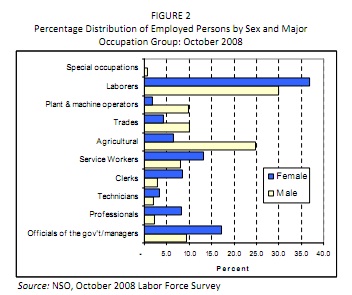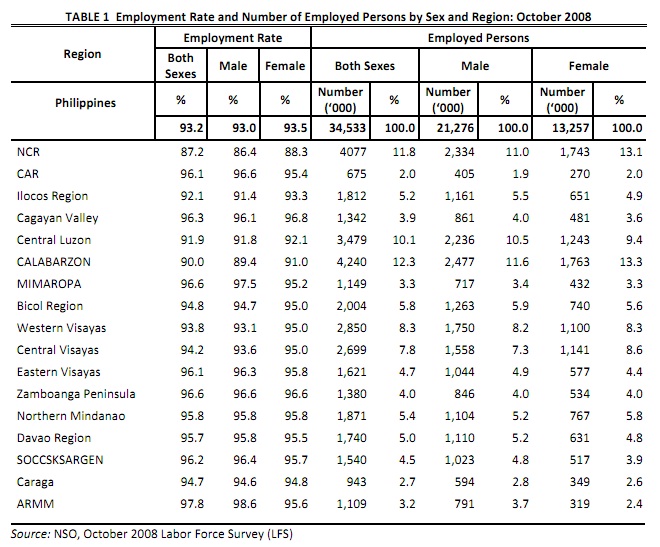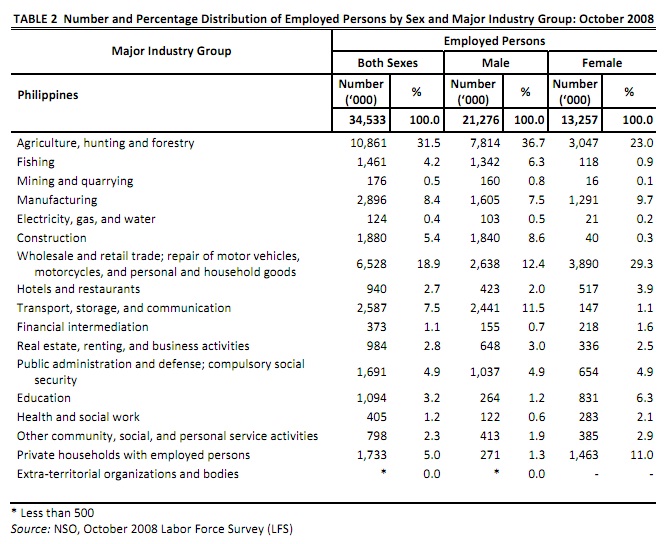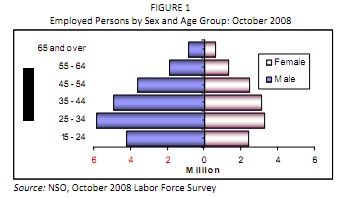Almost half of employed women are 25 - 44 years old
Employment among women is highest at age group 25 - 34 years at 24.8 percent, followed by those aged 35 - 44 years (23.5%), and 45 - 54 years (18.8%). Majority of employed men belong to the younger age groups, wherein 19.8 percent are 15 - 24 years old; 27.4 percent, 25 - 34 years old; and 23.1 percent, 35 - 44 years old.
One in three employed women reached college
The proportion of those who attended or completed high school and elementary among employed men (40.2% and 35.1%) are higher than that of employed women (36.4% and 28.1%). Among employed women, 33.7 percent attended or finished college while among employed men, 22.8 percent. 
Laborers and unskilled workers are the major occupation of women
Of the various occupation groups, the laborers and unskilled workers comprise the largest group among women, making up 36.8 percent of the total employed women in October 2008. Officials of the government and special interest organizations, corporate executives, managers, managing proprietors, and supervisors and service workers and shop and market sales workers came next with the most number of employed women totaling to 2.3 million (17.3%) and 1.7 million (13.1%), respectively. Among men, laborers and unskilled workers and farmers, forestry workers, and fishermen are the major occupation groups which constitute 29.9 percent and 24.8 percent of employed men, respectively.
Across occupation groups, those that are dominated by women are professionals with 69.0 percent women,clerks with 64.4 percent, officials of the government and special interest organizations, corporate executives, managers, managing proprietors, and supervisors with 53.4 percent, and service workers and shop and market sales workers with 50.6 percent. The rest of the occupation groups are highly dominated by males.
Of employed women, half are wage and salary workers
Of the total employed women in October 2008, 51.2 percent are wage and salary workers, mostly working for private establishments (29.4% of the total employed women). Among employed men, 52.4 percent are wage and salary workers, where majority also work for private establishments (44.5 percent of the total employed men). Those working for private households account for 11.0 percent of the total employed women and 1.3 percent of the total employed men.
Own account workers, such as proprietors and self-employed workers, constitute 30.6 percent of the total employed women, with the self-employed workers having the larger share (28.3% share of the total employed women). The proportion of self-employed workers among men is recorded at 33.3 percent. Employed women who are unpaid family workers are estimated at 18.2 percent while it was 9.0 percent among employed men.
Almost 30.0 percent of employed women are engaged in wholesale and retail trade
Wholesale and retail trade, repair of motor vehicles, motorcycles, and personal and household goods are the major industries women 15 years old and over are engaged in constituting 29.3 percent of employed women. Meanwhile, about 23.0 percent are in the agriculture, hunting and forestry industry, 11.0 percent are in private households with employed persons, and 9.7 percent in manufacturing industry.
Industry groups which are highly dominated by women are private households with employed persons (84.4 percent of those employed in the said industry group are women), education (75.9%), and health and social work (69.9%).






